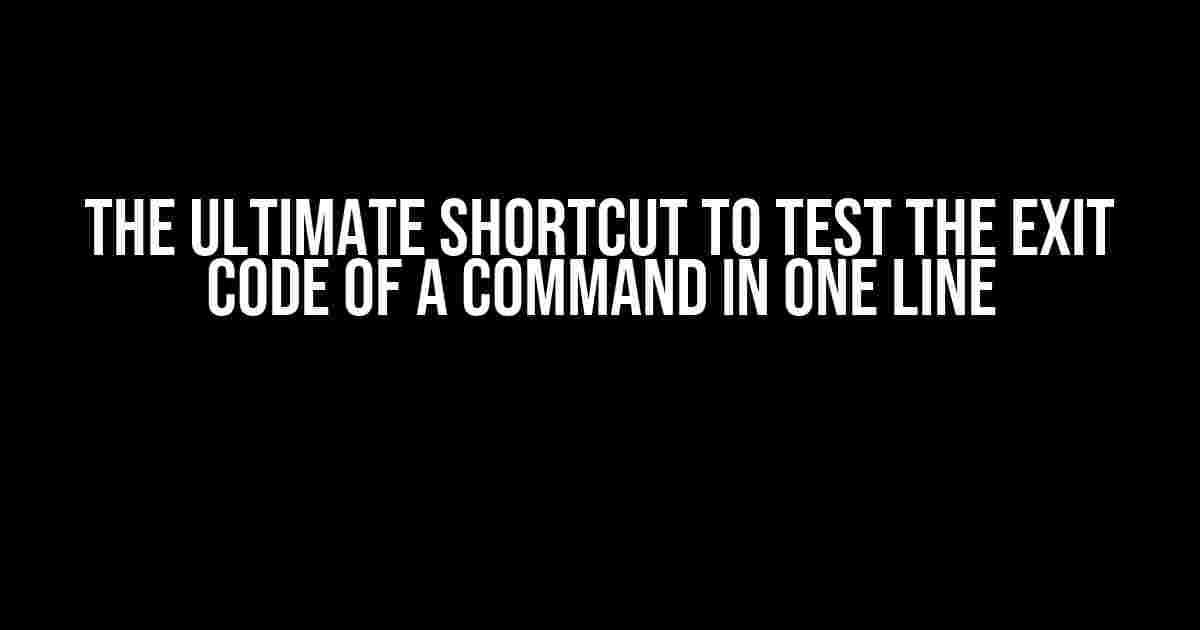Are you tired of writing tedious scripts to check the exit code of a command? Do you find yourself scrolling through lines of code just to verify if a command executed successfully? Well, buckle up, friend, because we’re about to revolutionize your coding workflow with a game-changing shortcut!
The Problem: Verifying Command Exit Codes the Hard Way
We’ve all been there – you write a command, and then you want to check if it executed successfully. Maybe you’re checking if a file exists, or if a process completed without errors. Whatever the reason, you know the drill: write a script, check the exit code, and then… well, then you’re left with a bunch of code that’s just taking up space.
#!/bin/bash
command && echo "Command succeeded!" || echo "Command failed!"
exit_code=$?
if [ $exit_code -eq 0 ]; then
echo "Command executed successfully!"
else
echo "Command failed with exit code $exit_code"
fi
Ugh, right? All that code just to check if a command worked. It’s like, can’t we just… you know, have a shortcut or something?
The Solution: The Magical One-Liner
Enter the ultimate shortcut: command && echo "Success!" || echo "Failure!". Yes, you read that right – a single line of code that checks the exit code of a command and prints a success or failure message. It’s like a coding superhero cape, minus the cape (but plus the awesomeness).
Let’s break it down:
command– Replace this with, well, the command you want to execute.&&– This is a logical AND operator. It means “only execute the next command if the previous one succeeded”.echo "Success!"– If the command succeeded, this will print “Success!” to the console.||– This is a logical OR operator. It means “if the previous command failed, execute the next one”.echo "Failure!"– If the command failed, this will print “Failure!” to the console.
Example: Checking if a File Exists
Want to check if a file exists? No problem! Use the one-liner:
test -f file.txt && echo "File exists!" || echo "File does not exist!"This will check if the file file.txt exists, and print a success or failure message accordingly.
Example: Checking if a Process Completed Successfully
Need to verify if a process completed without errors? Easy peasy:
my_command && echo "Command succeeded!" || echo "Command failed!"Replace my_command with, you guessed it, your command. This will execute the command and print a success or failure message based on the exit code.
The Power of Conditional Execution
But wait, there’s more! The && and || operators can be used to create more complex conditional execution scenarios. For example:
command1 && command2 && echo "Both commands succeeded!" || echo "One or both commands failed!"This will execute command1, and if it succeeds, execute command2. If both commands succeed, it will print “Both commands succeeded!”. If either command fails, it will print “One or both commands failed!”.
Advanced Conditional Execution
Want to get really fancy? Try using parentheses to group commands and create more complex conditional execution scenarios:
(command1 && command2) && command3 || echo "One or more commands failed!"This will execute command1 and command2 consecutively, and if both succeed, execute command3. If any of the commands fail, it will print “One or more commands failed!”.
The Benefits of the One-Liner
So, why is this one-liner so amazing? Here are just a few benefits:
| Benefit | Description |
|---|---|
| Concise code | One line of code instead of multiple lines of script. |
| Easy to read | Simple to understand and debug. |
| Flexible | Can be used with any command, and combined with other conditional execution operators. |
| Faster development | Write and test code faster with this shortcut. |
Conclusion
And there you have it, folks! The ultimate shortcut to test the exit code of a command in one line. No more tedious scripts, no more unnecessary code. With this one-liner, you’ll be coding like a pro in no time. So go ahead, give it a try, and experience the joy of coding simplified!
Happy coding, and don’t forget to share your favorite shortcuts in the comments below!
Frequently Asked Question
Want to know the secret to testing the exit code of a command in just one line? Dive in and find out!
What is the simplest way to test the exit code of a command in one line?
You can use the $? variable, which holds the exit status of the last command. For example: `cmd && echo “Success” || echo “Failure”` will print “Success” if the command `cmd` exits with 0, and “Failure” otherwise.
Can I use the if statement to test the exit code in one line?
Yes, you can! The syntax is: `if cmd; then echo “Success”; else echo “Failure”; fi`. This will execute the command `cmd` and print “Success” if it exits with 0, and “Failure” otherwise.
How can I test the exit code of a command and perform different actions based on the result?
You can use a conditional statement with the `&&` and `||` operators. For example: `cmd && action_if_success || action_if_failure`. This will execute `action_if_success` if `cmd` exits with 0, and `action_if_failure` otherwise.
Is there a way to test the exit code of a command and assign it to a variable in one line?
Yes, you can use command substitution to assign the exit code to a variable: `exit_code=$(cmd; echo $?)`. This will execute the command `cmd` and assign its exit code to the variable `exit_code`.
Can I test the exit code of a command and exit the script if it fails?
Yes, you can use the `set -e` command, which will exit the script if any command returns a non-zero exit code. For example: `set -e; cmd; echo “Success”`. If `cmd` fails, the script will exit immediately.
